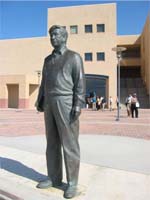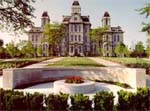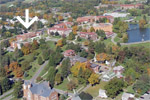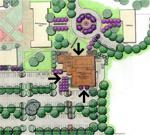| |
|
Terry O'Banion, in his book, A Learning College for the 21st Century, said “The learning college places learning first and provides educational experiences for learners anyway, anyplace, anytime.” Although the term “learning college” has its basis in the community college environment, the concept (or at least the term) has spread to 4-year and graduate institutions as well.
The learning campus shifts the “teachable moment” to the learning moment — “anyway, anyplace, any time.” The shift is from faculty giving and student taking to student doing.
Another shift in the learning campus is the understanding that all members of the institution are learners: students, faculty, staff, and administrators — a true community of learners.
What are the spatial implications of “anyway, anyplace, anytime” and what are the implications for campus planning?
The “learning campus” requires a fundamental change in the way that the college or university community interact, not just in the classroom, but also everywhere on campus and in every endeavor.
For one thing, a “learning campus” means that the classroom and lab are not and should not be the only places where learning takes place. Offices, lounges, dorm rooms, corridors, outdoor spaces, and the myriad formal and informal gathering spaces are all important to the learning experience.
For another, it means supporting the reality that people learn at different rates, with different tools, in different settings, with the need for introspection, and the need for interaction — learning is private and independent and learning is social and dependent. A campus needs spaces, inside and out, that recognize and encourage the diversity of learning styles and approaches
And for yet another, it means that there should be programs and places for faculty, staff, and administrators to work independently and in groups — to learn, to experiment, to assess what works, and to grow. An example of such programs is the Reflective Practice initiative at the University of New Hampshire, which encourages faculty to step back and assess what works, to work collaboratively, and to change the way faculty interact with their students.
In reflecting the “learning campus” the campus plan would include additional outdoor seating areas placed along well-traveled pedestrian routes; café options perhaps in the library or the prime athletic/recreation building; large faculty offices that would be an alternate venue for learning; small group collaboration spaces; studies and lounges of various sizes in the library and in other campus buildings, and space that would encourage interdisciplinary learning through centers and institutes or through facilitating interaction among academic departments.
The campus planning process itself should be a learning experience for the whole campus. What does planning actually mean? How do you build consensus? How do you set priorities? How do you create a vision for the future? How do you create an environment where all voices are heard and valued? What information is important? What are our values? The opportunities for learning are enormous — and the more you invite and involve faculty, staff, students, and administrators in the process, the greater the learning.
And it should be a learning experience for the consultant as well. We learn by listening, by understanding, and by learning the values and culture of an institution. The worst consultant is the one who comes to campus with the answers, with the solution, with the template, with the plan.

Arthur Lidsky
|
|
|







